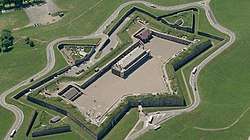Raid on Dartmouth (1751)
The Raid on Dartmouth (also referred to as the Dartmouth Massacre) occurred during Father Le Loutre's War on May 13, 1751 when a Mi'kmaq and Acadian militia from Chignecto, under the command of Acadian Joseph Broussard, raided Dartmouth, Nova Scotia, destroying the town and killing twenty British villagers and wounding British regulars. The town was protected by a blockhouse on Blockhouse Hill (close to the corner of King St. and North St.) with William Clapham's Rangers and British regulars from the 45th Regiment of Foot.[14] This raid was one of seven the Natives and Acadians would conduct against the town during the war.
| Raid on Dartmouth | |||||||
|---|---|---|---|---|---|---|---|
| Part of Father Le Loutre's War | |||||||
 John George Pyke, Only image of survivor of the Raid on Dartmouth (1751) | |||||||
| |||||||
| Belligerents | |||||||
|
Mi'kmaq militia Acadian militia |
| ||||||
| Commanders and leaders | |||||||
| Joseph Broussard (Beausoleil) |
Captain William Clapham Lt. Clark, Warburton's Regiment (wounded)[1][2] Sgt. ?, 45th Regiment †[3] Superior officer ?, 45th Regiment[4] † Captain Thomas Stannard (taken prisoner)[5][6] | ||||||
| Strength | |||||||
| 60 Acadian and Mi'kmaq[7] | 60 British regulars and rangers | ||||||
| Casualties and losses | |||||||
|
disputed: Cornwallis: 6 Mi'kmaq[8] Salusbury: one or two Mi'kmaq[9] |
disputed: Cornwallis: 4 killed; 6 prisoners;[10] Wilson's journal: 15 killed, 7 wounded (3 die in hospital), 6 prisoners;[11] Salusbury journal: 20 killed;[12] London Magazine: 8 settlers and a few officers killed, 14 prisoners[13] | ||||||
Historical context
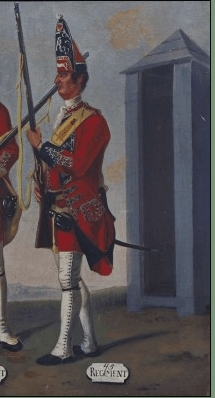

Despite the British Conquest of Acadia in 1710, Nova Scotia remained primarily occupied by Catholic Acadians and Mi'kmaq. To prevent the establishment of Protestant settlements in the region, Mi'kmaq raided the early British settlements of present-day Shelburne (1715) and Canso (1720), prior to entering into a Peace and Friendship Treaty with the British in 1726.
A generation later, Father Le Loutre's War began when Edward Cornwallis arrived to establish Halifax with 13 transports on June 21, 1749.[17]
By the time Cornwallis had arrived in Halifax, there was a long history of the Wabanaki Confederacy (which included the Mi'kmaq) protecting their land by killing British civilians along the New England/ Acadia border in Maine (See the Northeast Coast Campaigns 1688, 1703, 1723, 1724, 1745, 1746, 1747).[18][19][20]
The British quickly began to build other settlements. To guard against Mi'kmaq, Acadian and French attacks on the new Protestant settlements, British fortifications were erected in Halifax (Citadel Hill) (1749), Bedford (Fort Sackville) (1749), Dartmouth (1750), Lunenburg (1753) and Lawrencetown (1754).[21] There were numerous Mi'kmaq and Acadian raids on these villages such as the Raid on Dartmouth (1751).[22]
There was a raid on those in the Dartmouth area in 1749 (See Raid on Dartmouth (1749)). In response to the raids, Governor Edward Cornwallis created an extirpation proclamation against the Mik’maq on peninsula Nova Scotia and those that supported them.[23]
As well, to carry out this task, two companies of rangers were raised, one led by Captain Francis Bartelo and the other by Captain William Clapham. These two companies served alongside that of John Gorham's company. The three companies scoured the land around Halifax unsuccessfully looking for Mi'kmaq.[24]
In July 1750, the Mi'kmaq killed and scalped 7 men who were at work in Dartmouth.[25] In August 1750, 353 people arrived on the ship Alderney and began the town of Dartmouth. The town was laid out in the autumn of that year.[26] The following month, on September 30, 1750, Dartmouth was attacked again by the Mi'kmaq and five more residents were killed.[27] In October 1750 a group of about eight men went out "to take their diversion; and as they were fowling, they were attacked by the Indians, who took the whole prisoners; scalped ... [one] with a large knife, which they wear for that purpose, and threw him into the sea ..."[4]
In March 1751, the Mi'kmaq attacked on two more occasions, bringing the total number of raids to six in the previous two years.[28]
The Raid
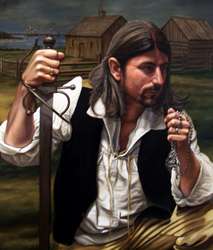
Three months later, on May 13, 1751 before sunrise, Broussard led sixty Mi'kmaq and Acadians to attack Dartmouth again, in what would be known as the "Dartmouth Massacre".[29] The raiding party came down the Shuebenacadie River from Chignecto.[30] Broussard and the others killed twenty settlers and more were taken prisoner.[31][32] Captain William Clapham and sixty soldiers of Hugh Warburton's regiment were on duty and fired from the blockhouse, which was located at the point overlooking Dartmouth Cove.[33] The raiding party tortured and mutilated the sergeant and wounded three other soldiers.[15]
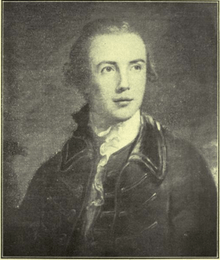
Captain Alexander Murray along with about 40 soldiers left Halifax in three vessels and tried to track them down for miles but most of the raiding party had dispersed.[34] The British reported they had killed six Mi'kmaq warriors, but were only able to retrieve one scalp that they took to Halifax.[35] Those at a camp at Dartmouth Cove, led by John Wisdom, assisted the settlers. Upon returning to their camp the next day they found the Mi'kmaq had also raided their camp and taken a prisoner.
The Mi'kmaq scalped all the settlers. The British took what remained of the bodies to Halifax for burial in the Old Burying Ground.[36] (John George Pyke survived the raid but his father John Abraham did not.)[37][38]
Aftermath
The British retaliated by sending several armed companies to Chignecto. A few French defenders were killed and the dikes were breached. Hundreds of acres of crops were ruined which was disastrous for the Acadians and the French troops.[39]
Immediately after the raid, a wooden palisade was erected around the town plot.[40] Mi'kmaq and Acadian attacks continued throughout the French and Indian War which ended fourteen years after Dartmouth was first settled. (For example, in the spring of 1759, there was another attack on Fort Clarence, in which five soldiers were killed.)[41] After the initial raid, no new settlers were placed in Dartmouth again for the next thirty years. Of the 383 settlers who arrived in Dartmouth on the Alderney in August 1750, only half remained two years later.[40] By the end of war (1763), Dartmouth was only left with 78 settlers.[42]
Similar raids happened in response to the British founding of Lawrencetown and Lunenburg, Nova Scotia, such as the Raid on Lunenburg (1756).
Fiction
Joseph Howe lived in Dartmouth and was well acquainted with its history. He included a Mi'kmaw raid on a British dwelling in his poem Acadia.[43] In the poem, Mi'kmaw fighters attack a British family of four in their house. Initially, the British family is able to defend themselves, killing 5 Mi'kmaw fighters. Eventually, however, the Mi'kmaw fighters are victorious and overwhelm the family, killing all those in the house.
See also
References
Part of a series on the |
|---|
| History of Halifax, Nova Scotia |
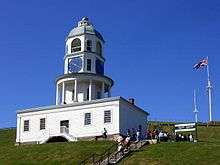 |
|
History
|
|
Events
|
|
Other
|
|
Primary Sources
- Wilson, John (1751). A Genuine Narrative of the Transactions in Nova Scotia since the Settlement, June 1749, till August the 5th, 1751. London: A. Henderson et al.CS1 maint: ref=harv (link)
- Expeditions of Honour: The Journal of John Salusbury (diarist)|John Salusbury in Halifax edited by Ronald Rompkey - 1982, p. 111
- London Magazine. Vol. 20. 1751. p. 419
- London Magazine. Vol. 20. 1751. p. 341
- Gentleman's Magazine, p. 379
- The Pennsylvania Gazette. August 1, 1751
- The Nova Scotia Magazine. Vol. 2, no. 4, (Apr. 1790) pp. 287–289
- Charles Morris
- The Nova Scotia Gazette and Weekly Chronicle, Sept. 1780
- Letters from Nova Scotia, Captain W. Moorsom. London, 1830, p. 29
Secondary Sources
- Akins. History of Halifax. Nova Scotia Historical Society. Vol. 8, p. 27
- Mrs. William Lawson. The History of The Townships of Dartmouth, Preston and Lawrencetown, Halifax County, Nova Scotia, 1893, p. 10
- Landry, Peter. The Lion & The Lily. Vol. 1, Trafford Publishing, Victoria, B.C., 2007.
- Rompkey, Ronald. Editor. Expeditions of Honour: The Journal of John Salusbury in Halifax, Nova Scotia, 1749-53. University of Delaware Press, Newark, 1982.
- Grenier, John (2008). The Far Reaches of Empire: War in Nova Scotia, 1710-1760. University of Oklahoma Press. ISBN 978-0-8061-3876-3.CS1 maint: ref=harv (link)
- Murdoch, Beamish (1866). A History of Nova-Scotia, Or Acadie. Vol. II. Halifax: J. Barnes.CS1 maint: ref=harv (link)
- Thomas Akins. History of Halifax, Brookhouse Press. 1895. (2002 edition)
- Harry Chapman. In the Wake of the Alderney.
- Faragher, John Mack (2005). A Great and Noble Scheme: The Tragic Story of the Expulsion of the French Acadians from Their American Homeland. W.W Norton & Company. ISBN 978-0-393-05135-3.CS1 maint: ref=harv (link)
Footnotes
- Lt. Clark was carried to Halifax and took weeks to recover before leaving with Gorham on the Osborn Galley to England (See Wilson (1751))
- https://archive.org/stream/cihm_20153#page/n19/mode/2up
- Salusbury's journal
- Wilson (1751).
- https://news.google.com/newspapers?nid=4p3FJGzxjgAC&dat=17520822&printsec=frontpage&hl=en
- Oct 7 - woman prisoner
- Murdoch (1866), p. 201, indicates there were 60 Mi'kmaq and Acadians.
- The British officers only produced one scalp. The British reported the other five bodies were retrieved by the natives. More likely the British inflated the numbers of the enemy they killed to mitigate prosecution for their inaction during the raid.
- Salsbury, Expedition of Honour, p. 111
- Grenier (2008), p. 160; Cornwallis' official report mentioned that four settlers were killed and six soldiers taken prisoner. See Governor Cornwallis to Board of Trade, letter, June 24, 1751, referenced in Harry Chapman, p. 29
- Wilson (1751) reported that fifteen people were killed immediately, seven were wounded, three of whom would die in hospital; six were carried away and never seen again".
- p.11; John Salusbury recorded in his diary that approximately twenty were killed (See Expeditions of Honour: The Journal of John Salusbury in Halifax, Nova Scotia, 1749-53. Edited by Ronald Rompkey. Newark: University of Delaware Press. 1982.p. 111)
- London Magazine. Vol. 20. 1751. p. 341
- Township of Dartmouth, p. 8 - location of blockhouse
- Wilson (1751), p. 16.
- Location of Dartmouth Blockhouse
- Grenier (2008); Thomas Beamish Akins. History of Halifax, Brookhouse Press. 1895. (2002 edition). p 7
- Scott, Tod (2016). "Mi'kmaw Armed Resistance to British Expansion in Northern New England (1676–1761)". Journal of the Royal Nova Scotia Historical Society. 19: 1–18.
- Reid, John G.; Baker, Emerson W. (2008). "Amerindian Power in the Early Modern Northeast: A Reappraisal". Essays on Northeastern North America, Seventeenth and Eighteenth Centuries. University of Toronto Press. pp. 129–152. doi:10.3138/9781442688032. ISBN 978-0-8020-9137-6. JSTOR 10.3138/9781442688032.12.
- Grenier, John. The Far Reaches of Empire. War in Nova Scotia, 1710-1760. University of Oklahoma Press, Norman, 2008.
- Grenier (2008)
- Grenier (2008), pp. 154–155; For the Raids on Dartmouth see the Diary of John Salusbury (diarist): Expeditions of Honour: The Journal of John Salusbury in Halifax; Wilson (1751); Also see http://www.blupete.com/Hist/NovaScotiaBk1/Part5/Ch07.htm
- Thomas Akins. History of Halifax, Brookhouse Press. 1895. (2002 edition). p 19; While the French military hired the Mi'kmaq to gather British scalps, the British military hired rangers to gather French and Mi'kmaq scalps. The regiments of both the French and British militaries were not skilled at frontier warfare, while the Mi'kmaq and Rangers were. British officers Cornwallis, Winslow, and Amherst both expressed dismay over the tactics of the rangers and the Mi'kmaq.Grenier (2008), p. 152; Faragher (2005), p. 405; Hand, p.99).
- Thomas Akins. History of Halifax, Brookhouse Press. 1895. (2002 edition). p 19; The first recorded encounter between the Mi'kmaq and these rangers happened on March 18, 1750 in the Battle at St. Croix.
- Thomas Atkins. History of Halifax City. Brook Hiouse Press. 2002 (reprinted 1895 edition). p 334
- Akins, p. 27
- Grenier (2008), p. 159
- For the two raids that happened in March 1751 see Grenier (2008), p. 160.
- Atkins, p. 27-28
- https://archive.org/stream/collectionsofnov02nova#page/n159/mode/2up
- Grenier (2008), p. 160; Cornwallis' official report mentioned that four settlers were killed and six soldiers taken prisoner. See Governor Cornwallis to Board of Trade, letter, June 24, 1751, referenced in Harry Chapman, p. 29; Wilson (1751) reported that fifteen people were killed immediately, seven were wounded, three of whom would die in hospital; six were carried away and never seen again".; John Salusbury recorded in his diary that approximately twenty were killed (See Expeditions of Honour: The Journal of John Salusbury in Halifax, Nova Scotia, 1749-53. Edited by Ronald Rompkey. Newark: University of Delaware Press. 1982.p. 111)
- Pote, William (1896). The Journal of Captain William Pote, Jr., during his Captivity in the French and Indian War from May, 1745, to August, 1747. New York: Dodd, Mead & Company. p. 52.
- Akins, p. 27-28
- Wilson (1751), p. 17.
- See anonymous private letter printed by Harry Chapman, p. 30.
- Wilson (1751); Harry Chapman, p. 29; Douglas William Trider list the 34 people who were buried in Halifax between May 13 - June 15, 1751. Four of whom were soldiers. (See History of Halifax and Dartmouth Harbour: 1415-1800. vol. 1, p. 69).
- p. 109
- p.29
- Faragher (2005), p. 272.
- Harry Chapman, p. 31
- Harry Chapman, p. 32; Faragher (2005), p. 410
- Harry Chapman, p. 32
- Joseph Howe. Acadia. In Poems and Essays. pp. 23-25
